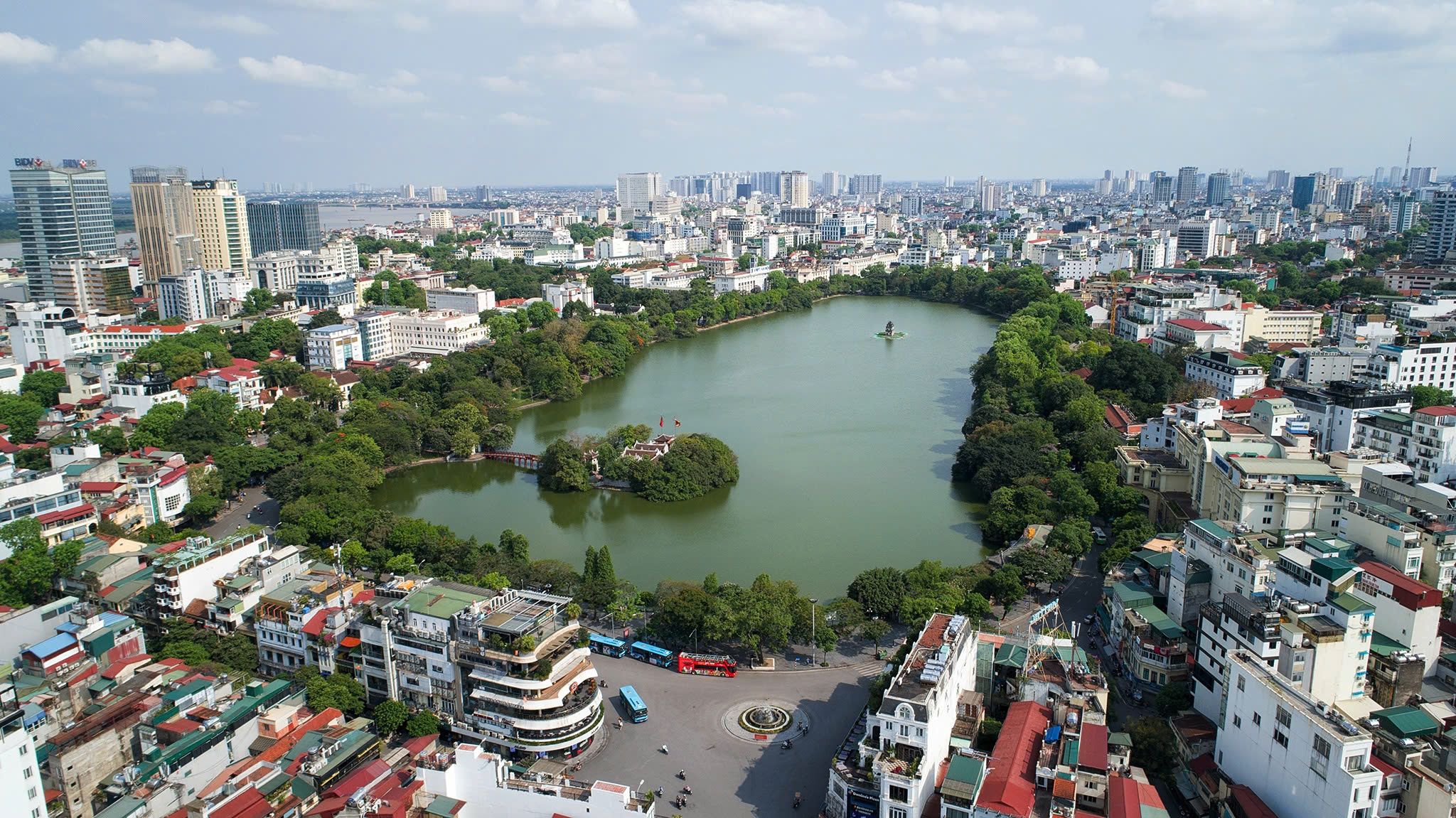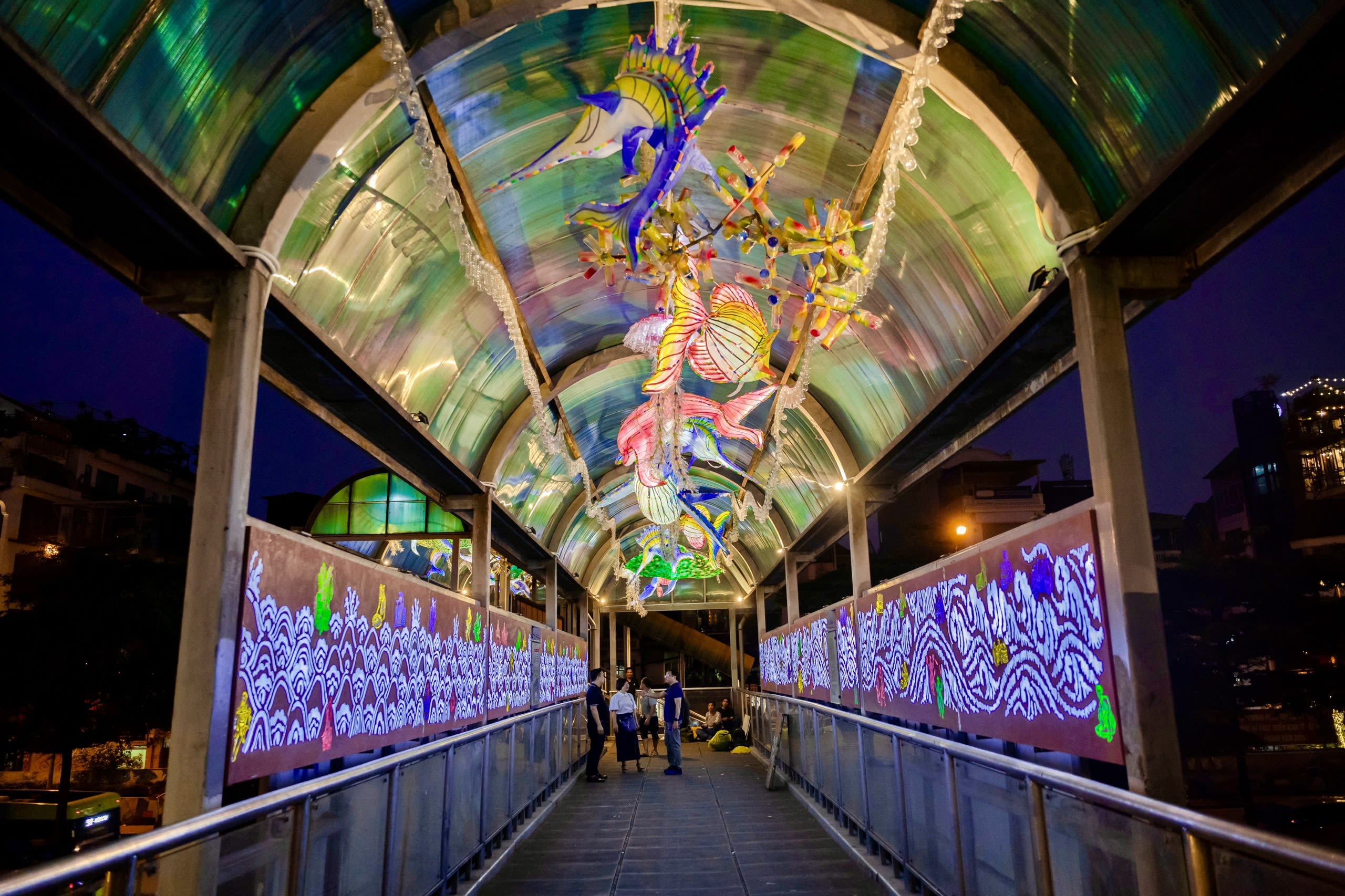Developing Hoan Kiem into a leading cultural industrial centre of the Capital City

Hoan Kiem District (Hanoi) is home to the Old Quarter with many French and Indochinese architectures. This is also the place where the cultural features of Thang Long - Ke Cho converge. From the heritage foundation, especially the existing architectural heritage in the Old Quarter, old streets and existing cultural spaces, Hoan Kiem is bringing cultural and artistic activities into every corner of life, to develop into the leading cultural industrial centre of the Capital City.
Heritage lies in heritage
The skylight — a unique design at the Heritage House No. 87 Ma May Street. (Photo: Hoan Kiem Lake and Hanoi Old Quarter Management Board)
The skylight — a unique design at the Heritage House No. 87 Ma May Street. (Photo: Hoan Kiem Lake and Hanoi Old Quarter Management Board)
Audience members enjoying traditional art performances in the heritage space of Hanoi's Old Quarter. (Photo: Hoan Kiem Lake and Hanoi Old Quarter Management Board)
Audience members enjoying traditional art performances in the heritage space of Hanoi's Old Quarter. (Photo: Hoan Kiem Lake and Hanoi Old Quarter Management Board)
The ancient beauty of the Heritage House at No.87 Ma May Street. (Photo: Hoan Kiem Lake and Hanoi Old Quarter Management Board)
The ancient beauty of the Heritage House at No.87 Ma May Street. (Photo: Hoan Kiem Lake and Hanoi Old Quarter Management Board)
A traditional art performance in Hanoi's Old Quarter. (Photo: Hoan Kiem Lake and Hanoi Old Quarter Management Board)
A traditional art performance in Hanoi's Old Quarter. (Photo: Hoan Kiem Lake and Hanoi Old Quarter Management Board)
The old neighbourhoods and structures from the French colonial period have left Hanoi, and Hoan Kiem in particular, with a unique architectural heritage. Many of these areas are being utilised for tourism activities or converted into cultural spaces.
If Hanoi is considered the “heart” of the whole country, Hoan Kiem District is a miniature image of the capital city. The structure of ancient East Asian cities often includes “citadel” and “town”, then the area of 36 streets located in Hoan Kiem District is the “town” area of the Thang Long Citadel.
Through its long history, Hoan Kiem District is a place that has retained many traces of space and time with the presence of many historical and cultural relics, revolutionary and resistance relics, and the cultural quintessence of the ancient land of Thang Long.
In particular, the most prominent is the Old Quarter with long-established streets, associated with the development history of the land of Thang Long - Ke Cho. Hanoians still call this area “Hang Street” — where each street produces and trades a certain product.
Thap Rua (Turtle Tower) in Hoan Kiem Lake - a symbol of Hanoi (Photo: Thanh Dat)
Thap Rua (Turtle Tower) in Hoan Kiem Lake - a symbol of Hanoi (Photo: Thanh Dat)
The way of naming streets according to professions and products has created the characteristics of the Old Quarter, with streets such as: Hang Muoi, Hang Mam, Hang Bo, Hang Buom, and Hang Khoai.
Up to now, there are still some households on Hang Bac Street that make jewellery and on Lan Ong Street that specialise in traditional medicine. Many streets have become attractive tourist routes, such as Hang Ngang, Hang Dao, Hang Bac, Hang Gai, and Ma May.
The entire Old Quarter became a national historical and cultural relic in 2004. There are dozens of relic sites in the Old Quarter. Therefore, Hanoi’s Old Quarter is known as a place where heritages lie within heritages.
A place that is considered the heart of the capital is Hoan Kiem Lake. There are architectural works that have become symbols of the capital such as: Turtle Tower, Ngoc Son Temple, and The Huc Bridge. Hoan Kiem Lake - Ngoc Son Temple was also recognised as a special national relic. The entire area of Hoan Kiem District is only 5.1 km2, but the district has as many as 190 historical and cultural relics of all kinds.
Kim Ngan Temple in the Old Quarter is renowned as a venue for cultural and artistic activities honouring the value of traditional culture. (Photo: Giang Nam)
Kim Ngan Temple in the Old Quarter is renowned as a venue for cultural and artistic activities honouring the value of traditional culture. (Photo: Giang Nam)
After Hanoi fell in the late 19th century, the French took over and continued to build Hanoi into a French-style urban area in the East. French-style streets, French architectural works, and French architecture mixed with Eastern architecture sprung up to create Indochinese architecture.
Most of these works are located in the districts of Hoan Kiem and Ba Dinh today, such as the Opera House, the Palace of the Governor of Tonkin (now the Government Guest House), and the Louis Finot Museum of the French School of the Far East (now the Vietnam National Museum of History) in addition to hundreds of villas scattered in the streets of Hai Ba Trung, Ly Thuong Kiet, Tran Hung Dao, Ly Thai To, Ngo Quyen, and Ba Trieu.
The old neighbourhoods and structures from the French colonial period have left Hanoi, and Hoan Kiem in particular, with a unique architectural heritage. Many of these areas are being utilised for tourism activities or converted into cultural spaces.
Culinary treasure trove
Throughout its long process of development, Hoan Kiem District has gathered and crystallised the cultural essences and historical traditions of the thousand-year-old capital city.
Among the heritages of Hoan Kiem, the most unique is its cuisine. The cuisine of the Old Quarter reflects the sophistication of Hanoians. Alongside Hanoi’s traditional dishes, the dishes introduced from other regions to the Old Quarter and crafted by local chefs have also become more distinctive with the flavour of Hanoi. Hoan Kiem’s cuisine today is more attractive with the many dishes carrying the essence of Hanoi offered by thousands of food establishments.
In the past two years, the prestigious culinary guide Michelin Guide has honoured many famous restaurants of Hanoi as well as of Vietnam in general. Hanoi’s cuisine makes up the majority of the restaurants recognised by Michelin in various categories.
One notable thing is that Hanoi’s restaurants honoured by Michelin are primarily located in Hoan Kiem District. Regarding pho, among the Hanoi six eateries recommended by Michelin, five are in Hoan Kiem District.
In addition to these five eateries, Hoan Kiem has many other ‘pho’ eateries that are favoured by the residents of the Old Quarter, namely Pho Man (Hang Giay Street), Pho Thin on the lake shore (Dinh Tien Hoang Street, Hoan Kiem District), and Pho Suong (Trung Yen Alley, Hoan Kiem District).
Other typical eateries also include Cha Ca La Vong and Bun Cha Dac Kim. There are also streets which gather many eateries and streets that are famous for unique dishes, such as Tong Duy Tan culinary street and Dong Xuan culinary alley. Visitors to the areas can explore many typical dishes and street food of Hanoi.
Regarding beverages, it is worth mentioning popular brands such as Giang Coffee and Lam Coffee, which are time-honoured coffee brands of Hanoi and have become attractive to both domestic and international visitors.
Chicken stewed served in Cay Si eatery on Tong Duy Tan street.
Chicken stewed served in Cay Si eatery on Tong Duy Tan street.
Shrimp fried rice – a popular dish that can be found in eateries on Tong Duy Tan street.
Shrimp fried rice – a popular dish that can be found in eateries on Tong Duy Tan street.
Promoting creativity for development

The pedestrian bridge over Tran Nhat Duat Street has now become a cultural and creative space. (Photo: Giang Nam)
The pedestrian bridge over Tran Nhat Duat Street has now become a cultural and creative space. (Photo: Giang Nam)
The pedestrian bridge over Tran Nhat Duat Street has now become a cultural and creative space. (Photo: Giang Nam)
The pedestrian bridge over Tran Nhat Duat Street has now become a cultural and creative space. (Photo: Giang Nam)
Following the Programme No. 06-CTr/TU of the City Party Committee titled ‘Developing culture, improving the quality of human resources, building elegant and civilised Hanoians in the period of 2021-2025’, and Resolution No. 09-NQ/TU of the Hanoi Party Committee titled ‘Developing cultural industry in the capital city in the period of 2021-2025 with orientations to 2030, vision to 2045’, Hoan Kiem District has implemented many activities to preserve and promote heritage values, especially through developing cultural industry.
In addition to the relics and scenic spots that have become famous tourist destinations, such as Hoan Kiem Lake, Ba Kieu Temple, Quan Chuong Gate, Kim Ngan Communal House, and Nam Huong Communal House, the district authorities have invested in restoring a series of relics such as Trung Yen Communal House, Ha Vi Communal House, Thanh Ha Communal House, and Pha Truc Lam Communal House. After restoration, many relics were transformed into creative spaces through the "Stories on Communal House in the City" project.
Tu Thi Communal House (Yen Thai Street) introduces artifacts and images about the birth and development of embroidery; traditional embroidery techniques, works of art applying embroidery techniques. Pha Truc Lam Communal House (Hang Hanh Street) inspires artists to create works related to the leather shoe industry and ancient shoes. Nam Huong Communal House located on Hang Trong Street has become an address to introduce Hang Trong folk paintings, works of artists inspired by Hang Trong folk paintings using many different materials: Lacquer, silk, gold-plated paintings and even hand embroidery.
The mural space on Phung Hung Street has become a venue for many exciting cultural and artistic activities. (Photo: Hoan Kiem Lake and Hanoi Old Quarter Management Board)
The mural space on Phung Hung Street has become a venue for many exciting cultural and artistic activities. (Photo: Hoan Kiem Lake and Hanoi Old Quarter Management Board)
Furthermore, Hoan Kiem has transformed many public spaces into creative spaces. Following Phung Hung Street Mural Space and Phuc Tan Street Art Space (Red River Art Street), the pedestrian bridge across Tran Nhat Duat Street has become a cultural space. Passing the bridge, the public can enjoy the Hang Trong painting with the theme "Leaping Over the Dragon's Gate" — a painting symbolising overcoming difficulties to achieve success, especially passing the examinations; or walking in an aquarium "tunnel" with fish "swimming" above with the work "Thuy Cung" (Aquarium).
These activities combined with pedestrian spaces around Hoan Kiem Lake, pedestrian spaces in the Hanoi's Old Quarter, traditional art performances in many cultural spaces have helped Hoan Kiem "retain" tourists. Recently, Hoan Kiem District has also deployed the Hoan Kiem Cuisine application to help tourists learn about and order restaurants and eateries in the most convenient way.
Chairman of Hoan Kiem District People’s Committee Pham Tuan Long affirmed that the district has been carrying out solutions to manage and promote the value of creative spaces to serve the development and industrialisation in the locality. In addition to managing and organising walking spaces and public art spaces, Hoan Kiem District continues to coordinate with artists and artisans to organise activities at cultural spaces such as the Heritage House at No.87 Ma May Street, Dong Lac Communal House at No.38 Hang Dao Street, Quan De Temple at No. 28 Hang Buom Street, and the Old Quarter Cultural Exchange Centre at No. 50 Dao Duy Tu Street. The process of "artifying" and "creating" public spaces in Hoan Kiem District still continues, which is contributing towards Hoan Kiem becoming a leading cultural industrial centre of the capital city.
Production Manager: Kieu Huong – Truong Son
Content: Giang Nam
Design: Diec Duong
Photos: Giang Nam, Thanh Dat, Hoan Kiem Lake and Hanoi Old Quarter Management Board











